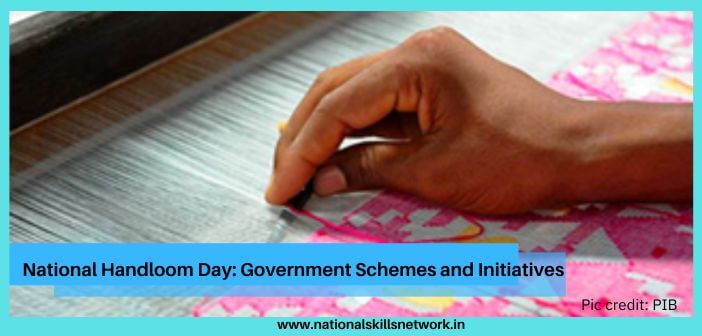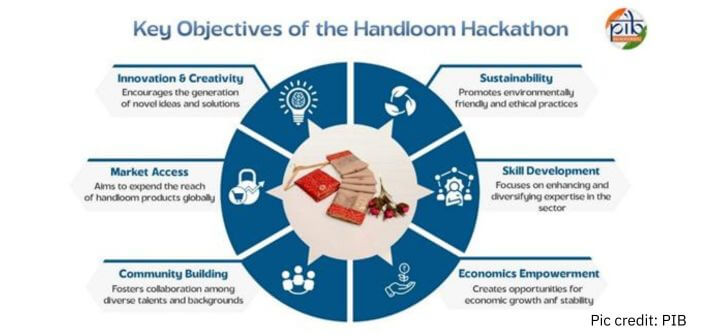Observed every year on August 7, National Handloom Day honours the handloom weaving community and brings attention to the vital role of this traditional sector in preserving India’s cultural heritage and supporting rural livelihoods. This year, the 11th National Handloom Day is being celebrated at Bharat Mandapam, New Delhi, in the presence of the Hon’ble President of India, who will confer prestigious awards to outstanding contributors in the field.
Beyond being a symbolic celebration, this day reaffirms the government’s commitment to strengthening the handloom sector through various schemes and initiatives that empower weavers, promote innovation, and expand market access.
Handlooms: A heritage woven into daily life
India’s handloom industry is one of the oldest and most vibrant cottage industries globally. With skills passed down over generations, handloom weaving continues to thrive in small towns and villages, often serving as a family’s main source of income.
According to the 4th All India Handloom Census (2019–20), more than 35.22 lakh households are engaged in handloom work, with over 72% of weavers being women. For many of them, weaving ensures both income and financial independence.

Handlooms are not just textiles; they represent stories of people, places, and traditions. From Banarasi to Kanjeevaram, every weave embodies India’s regional identity and is produced using eco-friendly, sustainable methods that support rural livelihoods.
India’s global presence in Handlooms
India remains the only major producer of handwoven fabric at scale, contributing to nearly 95% of the world’s handwoven textiles. While similar sectors have declined globally, India’s deep-rooted traditions and skilled workforce have sustained the handloom sector through generations.
In FY 2024-25, handloom exports from India reached over 20 countries, with the United States leading at ₹331.56 crore, followed by the UAE (₹179.91 crore), Netherlands (₹73.88 crore), France (₹66.14 crore), and the United Kingdom (₹65.6 crore). These figures reflect the international demand and cultural value of Indian handloom products.
Government schemes supporting the Handloom sector
The Ministry of Textiles implements several schemes aimed at improving productivity, ensuring fair wages, enabling market access, and preserving traditional skills.
The budgetary support under these schemes has grown steadily, from ₹219.85 crore in 2020-21 to over ₹367.67 crore in 2024-25 reflecting the government’s increased focus on revitalising the handloom and handicraft sectors.
The key schemes are:
1. National Handloom Development Programme (NHDP)
This flagship scheme promotes the sustainable development of handloom weavers by supporting both individual artisans and producer groups. It provides:
- Skill upgradation
- Access to raw materials
- Design innovation and technology upgrades
- Market access through exhibitions and permanent infrastructure
Key Components of NHDP:
- Small Cluster Development Programme
- Handloom Marketing Assistance
- Weavers MUDRA Loan Scheme
These components take a holistic, need-based approach to ensure self-reliant and competitive handloom units. The National Handloom Development Programme (NHDP) aims to promote the sustainable growth of handloom weavers in and outside recognised clusters by forming self-reliant and competitive units.
The scheme takes a need-based, holistic approach to support weavers. It provides help with raw materials, design, technology upgrades, marketing through exhibitions, and building permanent infrastructure like Urban Haats and marketing complexes.
2. Raw Material Supply Scheme (RMSS)
Under this scheme, subsidized yarn is provided to weavers to ensure the timely availability of quality raw material. As detailed in our earlier article, this includes transportation subsidies and the use of yarn passbooks and yarn depots.
- Through the National Handloom Development Corporation, the Yarn Supply Scheme (YSS) is being implemented throughout the nation to make all varieties of yarn accessible at Mill Gate Price.
- All types of yarn are eligible for reimbursement of freight costs under the Scheme, and hank yarn for cotton, domestic silk, wool, and linen yarn is also eligible for a 10% price subsidy with quantity restrictions.
Weavers Mudra Scheme
- The program’s objective is to allow banks to adequately and promptly support the country’s handloom industry in meeting its credit needs for term loans and working capital.
- The handloom weavers are given credit under the Weaver MUDRA Scheme at a special interest rate of 6%. A maximum of Rs. 10,000 in margin money support and a 3-year credit guarantee are also offered to weavers.
- To reduce delays in the distribution of funds for margin money and interest subvention, MUDRA Portal has been established in collaboration with Punjab National Bank.
To learn more about the key schemes that are transforming the handloom ecosystem, read our article on Top 5 Handloom Development Schemes from the Government of India.
Digital and strategic initiatives
1. Digital Marketing Support via GeM and indiahandmade.com
More than 1.80 lakh weavers have been onboarded to the Government e-Marketplace (GeM), enabling direct sales to government departments. Additionally, the Ministry launched indiahandmade.com, where 2418 sellers have listed over 11,410 products, expanding digital reach and consumer access.
2. Geographical Indications (GI) for Traditional Designs
To protect the unique identity of regional weaves, the Ministry has facilitated GI registration for 104 handloom products under the Geographical Indication of Goods Act, 1999, out of a total of 658 GI-tagged products in India. Awareness programmes, workshops, and seminars further support this initiative.
3. Hathkargha Samvardhan Sahayata (Looms and Accessories Scheme)
This scheme supports weavers in upgrading to improved looms, jacquards, dobbies, and related accessories to enhance fabric quality and productivity. The Government of India provides 90% of the cost, with implementation done in coordination with State Governments.
Recognising excellence: National Awards
As part of the 11th National Handloom Day celebration, the Sant Kabir Handloom Awards and National Handloom Awards for 2024 will be presented to a total of 24 awardees—5 Sant Kabir Awardees and 19 National Awardees.
These awards fall under the Handloom Marketing Assistance (HMA) component of NHDP and aim to honour exceptional weavers, designers, marketers, start-ups, and producer groups.
- Sant Kabir Award: ₹3.5 lakh, gold coin (mounted), Tamrapatra, shawl, and certificate
- National Handloom Award: ₹2 lakh, Tamrapatra, shawl, and certificate
Innovation for the future: Handloom Hackathon 2025
In a forward-looking move, the Ministry of Textiles organised the Handloom Hackathon 2025 on 4th August 2025 at IIT Delhi’s Research and Innovation Park, in collaboration with the National Design Centre and FITT, IIT Delhi.
Under the theme “DREAM IT; DO IT”, the hackathon invited participation from students, fashion designers, engineers, researchers, and weavers. Selected ideas received national recognition and continued support for implementation. The initiative encouraged innovation-led problem-solving while building long-term networks to support sector growth.

Week-long Celebrations: 1st to 8th August 2025
The Ministry has also curated a week-long series of events in New Delhi to honour India’s handloom heritage and engage newer audiences through exhibitions, workshops, and discussions around handlooms and sustainability.
Sustaining tradition through support and innovation
The Indian handloom sector is a strong symbol of the country’s culture, artistry, and rural economy. It provides sustainable livelihoods to millions, especially women. It also encourages eco-friendly and traditional methods of production that are gaining value worldwide.
On National Handloom Day, it’s important to recognise the role of government schemes, digital platforms, and other initiatives that help weavers preserve their craft. With continued support in areas like innovation, marketing, and infrastructure, India’s handloom legacy can thrive for generations to come.
















